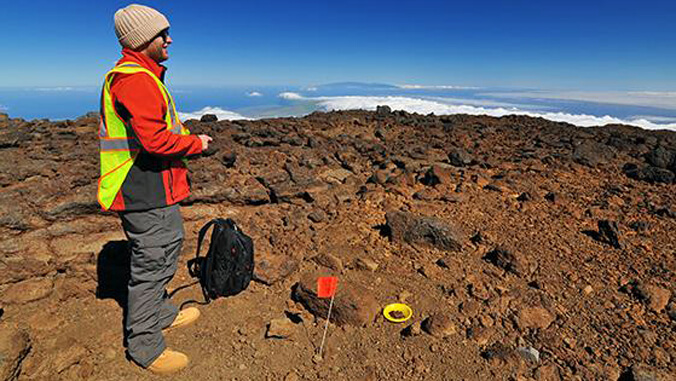
High atop the slopes of Maunakea, the alpine stone desert and subalpine māmane scrub habitats are home to the endemic wēkiu bug. This stone desert endemic insect, found only on this volcano, survives among some of Hawaiʻi’s most iconic native flora and fauna.
To improve conservation and management efforts for these and other high-elevation invertebrates, University of Hawaiʻi at Mānoa graduate student researcher Brad Reil and advisor Dan Rubinoff from the College of Tropical Agriculture and Human Resources (CTAHR) have traded in their T-shirts for winter wear to conduct in-depth field work in the alpine stone desert and subalpine māmane woodlands on Maunakea. Since 2018, they’ve collected wēkiu bug and other arthropod specimens to learn about the arthropods’ habits and dietary requirements, effects of introduced species and available resources between the alpine and subalpine habitats. The research duo is on a mission to map the food web connecting the mountain’s species.

“Maunakea is a special place for many reasons,” Reil explained. “Ecologically, the endemic species that call the mountain home are found nowhere else on earth and have adapted to the harsh dry cold conditions on the volcano. At the summit, the aeolian stone desert ecosystem obtains much of its resources from wind-borne materials (bits of plants, dead insects, dust, etc.) instead of plant species, resulting in uniquely adapted inhabitant species such as the wēkiu bug.”
- Related UH News story: First endangered ʻuaʻu observed on Maunakea in more than 60 years, July 8, 2021
The multi-year study funded by the UH Hilo Center for Maunakea Stewardship (previously the Office of Maunakea Management) is nearly complete. Reil, who works in CTAHR’s Insect Systematics and Biodiversity Lab, will soon switch from the specimen collection phase to processing and analyzing results before writing final reports.
“This research is exciting because it will provide information about the underlying interactions between the arthropod species that support these diverse habitats, and will help to ensure we have the knowledge necessary to properly manage and conserve them,” added Reil.
This effort/work/program/research/outreach/event is an example of UH Mānoa’s goal of Enhancing Student Success (PDF) and Excellence in Research: Advancing the Research and Creative Work Enterprise (PDF), two of four goals identified in the 2015–25 Strategic Plan (PDF), updated in December 2020.

